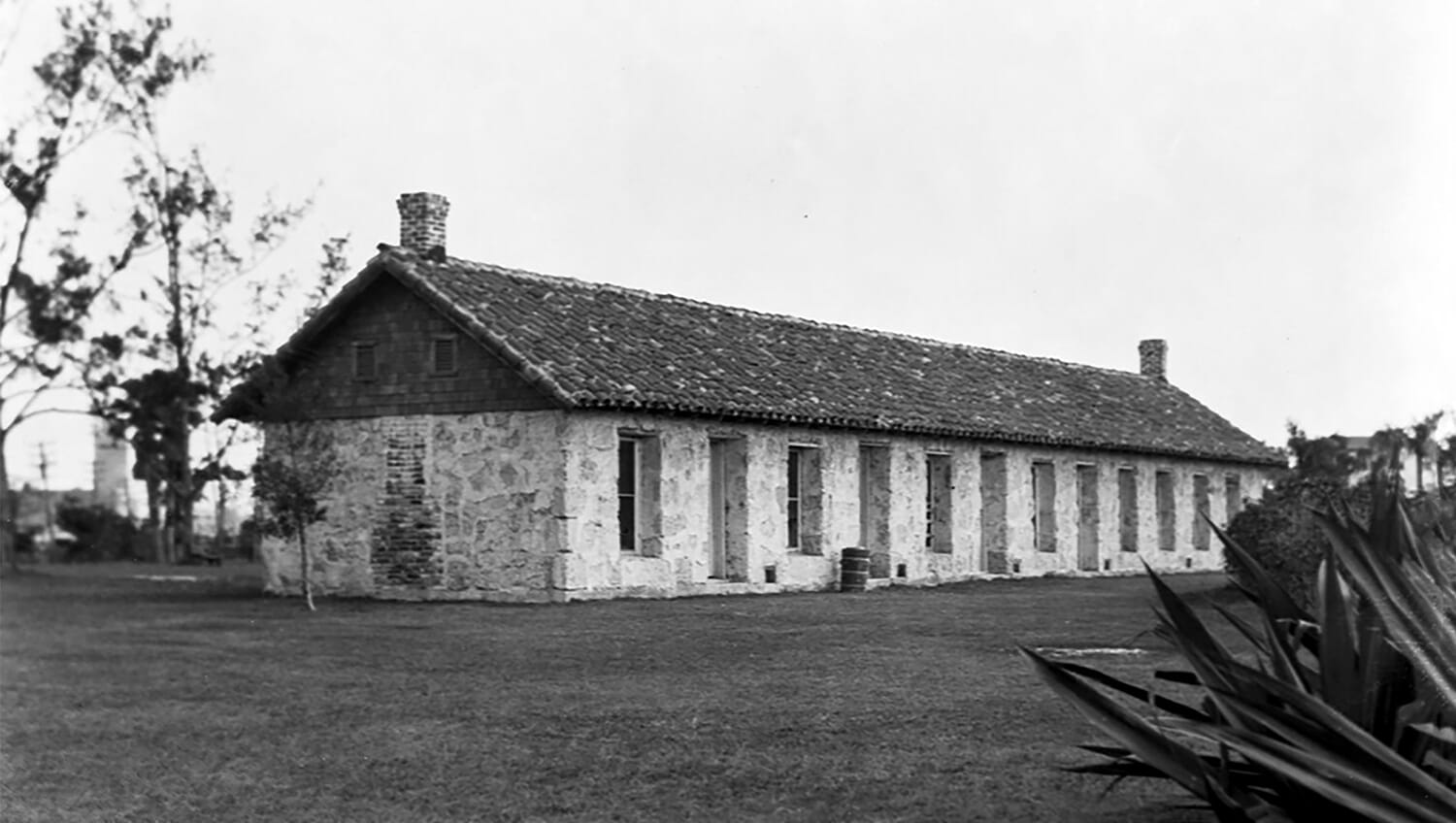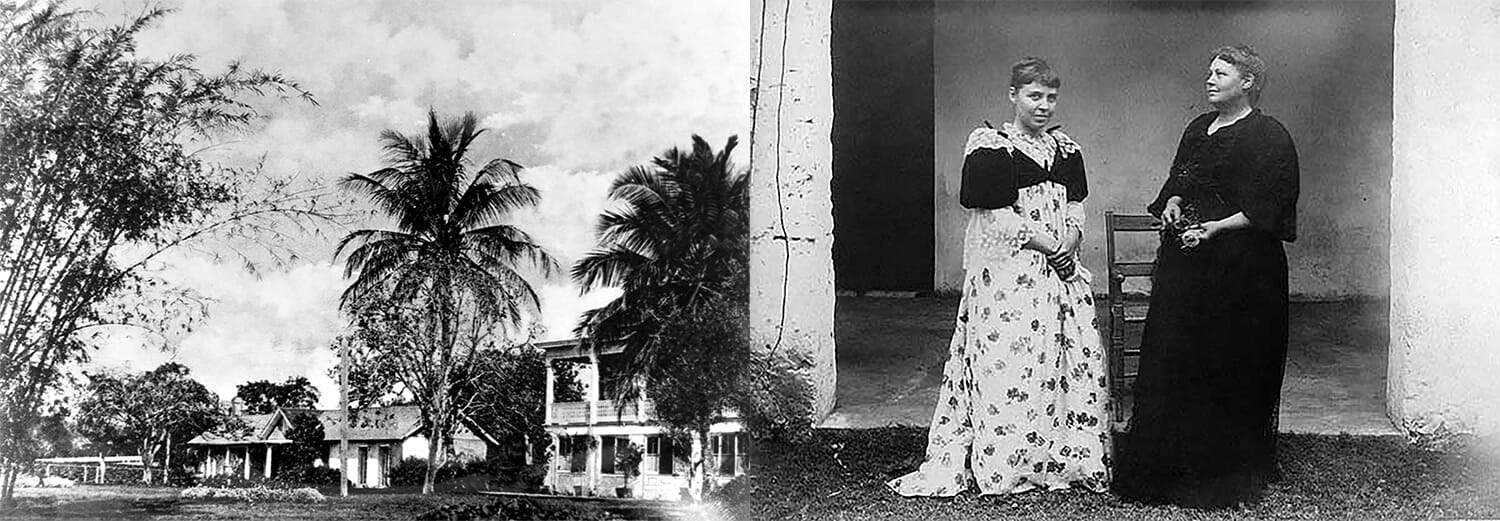
Figure 1: Fort Dallas Barracks in Lummus Park in 1933
The Fort Dallas Barracks were constructed a few years after William English purchased property once owned by his uncle, Richard Fitzpatrick, who purchased and occupied the land on the north and south side of the Miami River from the late 1820s until the onset of the Second Seminole War in 1835. By 1838, the army had taken over Fitzpatrick’s property to establish Fort Dallas during the war, which ended on August 14, 1842, at which time the U.S. government conveyed the land back to Fitzpatrick. It was shortly after the end of the war, on May 20, 1843, when English purchased the tract of land from his uncle.
In early 1849, a team of men from the U.S. Coast Survey visited the mouth of the Miami River to map the area when they reported that English was constructing a large rock mansion on the north bank of the river, along with a rock slave quarters nearby. During that same year, a U.S. Inspector was killed by a group of Seminole Indians near Indian Creek which prompted the government to recommission Fort Dallas in the latter part of 1849. It was during this time that the U.S. Army took over English’s property and completed the mansion and slave quarters, which was used to provide barracks for the infantry men who were stationed at the fort.
Length of Video: 7 minutes, 23 seconds (Publish Date: April 9, 2024)
Prior to the government taking over his land, William English had a dream of creating the Village of Miami, where he had already platted out parts of the south side of the river and assigned street names to this small parcel of land he intended to market and sell. After his land was recommissioned as Fort Dallas, he learned about the riches being mined in California during the Gold Rush and then headed west. He arrived in California in April of 1851 where he had hoped to mine enough gold to finance his vision of creating the Village of Miami. However, his dream ended when his rifle unexpectedly discharged while he was dismounting his horse, tragically ending his life.
William’s mother, Harriet, and his brother, John, inherited the property at the mouth of the Miami River as a result of his passing. After the Third Seminole War concluded in 1858, Fort Dallas was decommissioned, and the land and buildings were transferred back to the English family. During this time, the Fort Dallas Barracks building served the role of Dade County Seat from 1844 until 1888, when the seat was relocated north to Juno.
By the 1860s, Harriett English owned the full tract of land on both sides of the Miami River when she sold the territory on the north side of the river to Dr. J.V. Harris of Key West, Florida, who later sold the property to the Biscayne Bay Company in the 1870s. In 1874, J.W. Ewan, who later became known as the ‘Duke of Dade’, became the caretaker of the property, and established himself as one of the more notable characters in South Florida during the couple of decades leading up to the incorporation of the City of Miami.

Figure 2: Fort Dallas during Tuttle ownership and Julia and Frances Tuttle in front of the barracks on the day of Frances’ wedding
Julia Tuttle Purchases Fort Dallas in 1891
It was Ewan who brokered the deal to sell the property to Julia Tuttle in 1891. Julia converted the large mansion into the family residence, while the barracks were used for a variety of purposes after the 1891 transfer of ownership to the Tuttle family.
The Fort Dallas Barracks served as the site of Frances, daughter of Julia, marriage to Charles Conrad Sanders on April 12, 1897. After Julia died on September 14, 1898, her son, Harry, assumed ownership of the residence, which he converted into the Seminole Club in the early 1900s. When the Woman’s Club sold their Flagler Street property to construct a larger clubhouse in Edgewater in the early 1920s, they moved club operations and the public library temporarily into the former Tuttle residence. The barracks building was primarily used as a meeting venue from 1898 until the early 1920s, when it was converted into the Fort Dallas Tea Room, which was the meeting venue for Everglades Chapter of the Daughters of the American Revolution.
In 1925, the property was sold to R.C. Hogue of Norfolk, Virginia, who immediately filed to have both the residence and barracks buildings condemned and razed to make room for the 11-story Robert Clay Hotel. The property was purchased for a reported $185,000, but concerns about losing the last remaining buildings of Fort Dallas inspired a couple of women’s groups to initiate a campaign to preserve the Fort Dallas Barracks.

Figure 3: Fort Dallas Barracks being moved in April of 1925
Barracks Moved and Bronze Tablet
Upon hearing the plans for the Fort Dallas site along the Miami River, members of the Miami Woman’s Club, as well as, those associated with the Everglades Chapter of the Daughters of the American Revolution (DAR), began an initiative to acquire the barrack’s building, and raise money to have it moved to Miami’s oldest green space, Lummus Park, which is situated along the Miami River west of the former Fort Dallas site. The two groups were able to convince Hogue to donate the building to the City of Miami on behalf of the Woman’s Club, and were successfully able to raise enough money to fund its movement to the park.
In the Spring of 1925, work began to disassemble the one-story barracks building, brick by brick, place the assemblage of blocks onto a barge, and then move it down the Miami River where the building was reassembled to complete the move from Fort Dallas Park to Lummus Park. The only section of the building that could not be moved was the roof of the structure. The workers added a new roof onto the old structure which ended up being the one part of the building that was problematic in its new location.
In addition to donating the barracks building to be preserved, R.C. Hogue also agreed to allow for a bronze plaque to be placed onto the Robert Clay Hotel to commemorate the former location of Fort Dallas. In a ceremony that took place on February 22, 1927, on Washington’s birthday, the Daughters of the Revolution (DAR), unveiled the marker affixed to the hotel near the building’s entrance during an event that featured Mary Brickell, granddaughter of William and Mary, as part of the event to reveal the bronze tablet.

Figure 4: Fort Dallas Bronze Tablet on the Robert Clay Hotel in 1927. Mary Brickell, granddaughter of William and Mary, seen on left, along with Gertrude Thompson (right), were part of the ceremony to reveal the bronze tablet
Approaching 100 Years in Lummus Park
Within the first decade after being moved to Lummus Park the barrack’s building roof collapsed. It was the first major repair needed for the building after the move, and required the city to affix a more permanent top in order to properly preserve the building for future generations.
While the building is approaching a 175-year milestone since it was constructed, initially by William English but completed by the army to fortify Fort Dallas in 1849, it is within a year of reaching the 100-year anniversary since it was moved from its original site to Lummus Park in 1925. Miami is not known for preserving its heritage, so it is consequential to have a building, such as the Fort Dallas Barracks, preserved and available in a public space to be able to share the story of Miami’s early history.
Click on the video (top of page), to watch a more than seven-minute pictorial history capturing the different periods for the Fort Dallas Barracks, along with a video tour of the exterior and interior of the building in 2016.
Click Here to Subscribe
Photos:
- Cover: Fort Dallas in the 1880s. Courtesy of Florida State Archives.
- Figure 1: Fort Dallas Barracks in Lummus Park in 1933. Courtesy of Miami-Dade Public Library, Romer Collection.
- Figure 2: Fort Dallas during Tuttle ownership and Julia and Frances Tuttle in front of the barracks on the day of Frances’ wedding. Courtesy of HistoryMiami Museum.
- Figure 3: Fort Dallas Barracks being moved in April of 1925. Courtesy of Florida State Archives.
- Figure 4: Fort Dallas Bronze Tablet on the Robert Clay Hotel in 1927. Mary Brickell, granddaughter of William and Mary, seen on left, along with Gertrude Thompson (right), were part of the ceremony to reveal the bronze tablet. Courtesy of Miami-Dade Public Library, Romer Collection.
Music:
- Music track: Inspiring People by Aylex | Source: https://freetouse.com/music | Copyright Free Music
